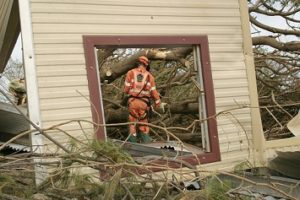Thousands of people are involved in cleaning up from the devastation and flooding caused by Hurricane Harvey. The work can be slow and disheartening. It can also be dangerous. If your employees are performing recovery work, OSHA recommends you first assess the potential for hazardous conditions and/or exposures before starting work. Based on an initial assessment, the next step is to provide workers with the appropriate personal protective equipment, training, and information they need to work safely.
While risks vary depending on the specific tasks and the environment, OSHA has outlined a variety of possible hazards and protective measures that may apply to your operation and crews.
Contaminated Floodwaters
- Ventilate enclosed spaces with fresh air.
- Assume that floodwater is contaminated unless proven otherwise.
- Allow only trained workers with the proper PPE to clean up toxic chemicals, waste, and mold.
- Make sure tetanus shots are up-to-date (within 10 years).
- Discard water-damaged and visibly contaminated materials.
- Use waterproof boots, latex or rubber gloves, and other protective clothing.
- Use an N-95 NIOSH-approved disposable respirator, at a minimum, when handling mold-contaminated materials.
- Maintain a supply of clean water for drinking and washing.
Downed Power Lines
- Assume that all power lines are live or energized.
- Establish and clearly mark a danger zone around down lines; stay at least 10 feet away.
- Allow only properly trained and equipped workers to repair electrical wires.
Tree Trimming and Debris Removal
- Contact the utility company to de-energize and ground or shield power lines.
- Establish and clearly mark a danger zone where debris may fall onto workers.
- Use work gloves, a hard hat, work boots, hearing protection, and eye/face protection. Wear chaps when operating a chainsaw.
- Watch out for chainsaw kickback; do not cut with the saw tip.
- Don’t get too close to a chipper and never reach in.
- Use mechanical equipment to lift heavy objects. If not possible, use extra people and proper lifting techniques.
Falls
- Use safety procedures to prevent aerial lift tip-overs; use a body harness or restraining belt with a lanyard attached to the boom or basket.
- Use proper ladder safety techniques.
- Be aware of wet, slippery, or uneven surfaces.
Portable Generators
- Never run a portable generator inside a house or enclosed space.
- Inspect cords to ensure they are in good condition with no frays. Use a ground-fault circuit interrupter (GFCI).
- Ensure that spaces where generators are used are properly ventilated.
- Shut down the generator before refueling.

